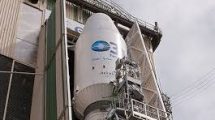 Wang Yaping became the first Chinese woman taikonaut to walk in space as she moved out of the under-construction space station.
Wang Yaping became the first Chinese woman taikonaut to walk in space as she moved out of the under-construction space station.
Yaping and fellow taikonaut Zhai Zhigang, two of the three-member team currently at China’s new Tiangong space station, successfully completed the 6.5-hour spacewalk in the early hours of Monday morning, November 8, according to the China Manned Space Agency (CMSA).
The third member of the Shenzhou-13 crew, Ye Guangfu, stayed on the space station to support the spacewalk from the core module.
During the spacewalk, the team installed a suspension device and transfer connectors to the station’s robotic arm. They also tested the safety of supporting equipment, including China’s domestically produced spacesuit.
China had launched the Shenzhou-13 spaceship on October 16, sending three astronauts on a six-month mission to the under-construction space station which was expected to be ready by next year.
In March 2012, Yaping was part of the backup crew for the ninth manned Shenzhou mission series in June 2013 and took part in the 10th of Shenzhou series which lasted nearly 15 days. She is the second Chinese woman to have flown in space.
During the Shenzhou 10th flight, Yaping gave China’s first space-based lecture inside the Tiangong I experimental module to more than 60m Chinese students at about 80,000 schools across the country.
She was selected for the present manned space mission in December 2019.
The mission further tested the functions of the indigenously developed new-generation extravehicular spacesuits, the coordination between the astronauts and the mechanical arm, and the reliability and safety of supporting equipment related to the EVAs.
This is the second manned mission for China’s space station, which is under construction. Earlier, three other astronauts —Nie Haisheng, Liu Boming and Tang Hongbo— returned to earth on September 17 after a successful three-month stay in the space station module during which they carried out several tasks to build it.
Billed as the most prestigious and strategically important space project for China after the country’s recent Mars and previous Moon missions, the low orbit space station would be the country’s eye from the sky, providing round a clock bird’s-eye view on the rest of the world.
China’s space station is also equipped with a robotic arm over which the US has raised concerns for its possible military applications. Astronauts will team up with the robotic arm to make in-orbit space station construction and maintenance possible.
China is building the space station by sending a series of space missions including the cargo craft, which docked with the Tianhe core cabin module. The Tianhe was launched on April 29.












Add Comment